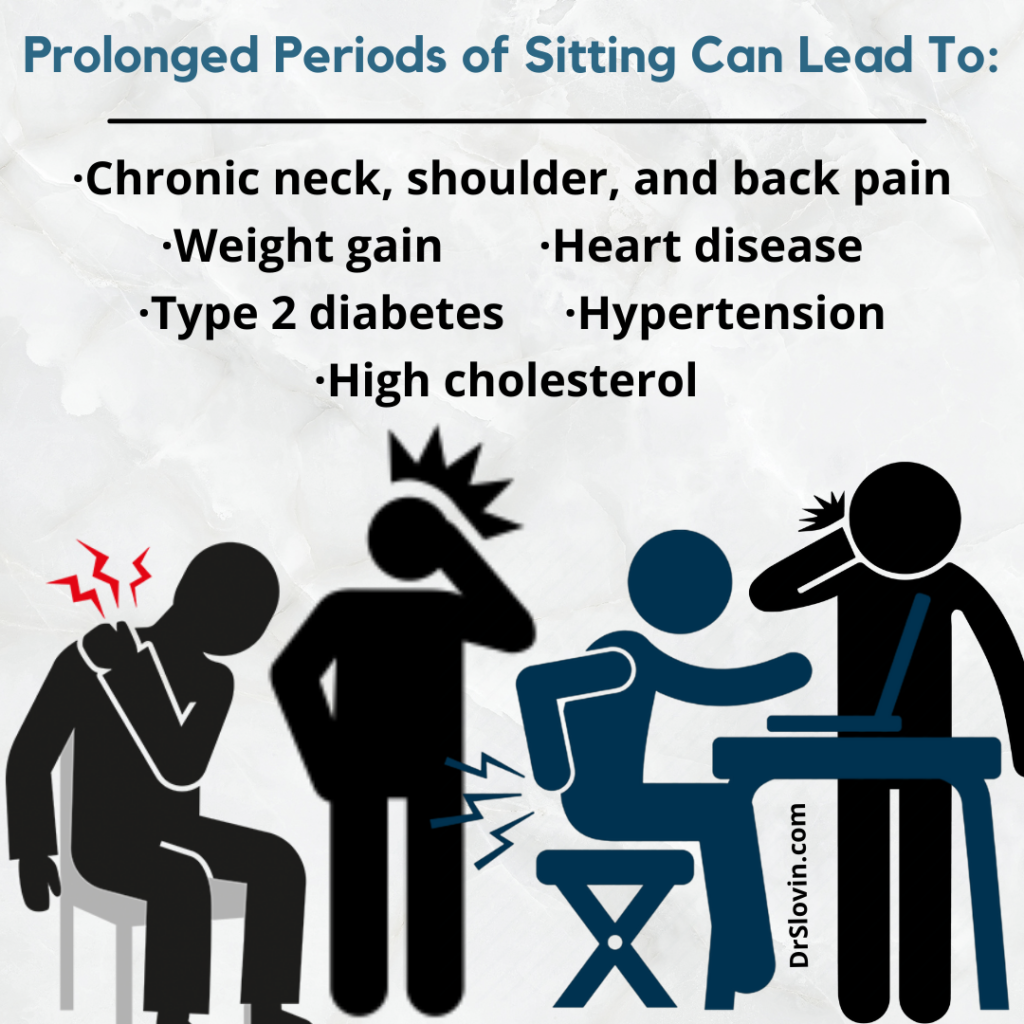Should You Get A Standing Desk for Back Pain?

Should You Get A Standing Desk for Back Pain?
We do it all the time. We do it while driving, working, eating, watching TV, waiting for appointments, and even while going to the bathroom. We sit constantly, and because of too much sitting, symptoms of neck and back pain worsen. Back pain is the most common medical problem we treat as chiropractors. In the U.S. alone, it affects 8 out of every 10 people, so isn’t it time we find ways of combatting this rising problem? With other healthy lifestyle measures, a standing desk can help improve back pain.
Sitting with Back Pain: The Science
First, let’s review some of the bad things that happen to our bodies in a sedentary (primarily sitting) lifestyle. In 2017, a study published in Annals of Internal Medicine reported that sitting throughout the day for long periods contributes to an increased risk of death. Plenty of studies exist that warn us against a sedentary lifestyle too. Prolonged periods of sitting can lead to:
· Weight gain
· Heart disease
· Type 2 diabetes
· Hypertension
· High cholesterol
Much can go wrong when we don’t move our bodies. A standing desk could be a simple solution to combat any of the above, but there are other benefits.

The Benefits of Using a Standing Desk for Back Pain
Standing desks are still relatively new to the market, but they’re touted as helping improve posture, increase productivity, and relieve aches and pains in the back, shoulders, and neck. There haven’t been extensive studies, so some of the benefits are observed and assumed based on a comparison to sitting all day.
· Researchers found that those who spend more time standing have better-regulated blood sugar. Levels return to normal faster after meals on those days.
· That same study found there’s a slightly higher calorie burn when you’re standing.
· People who use standing desks report higher energy and productivity.
· There are also reports of better focus and concentration.
A standing desk may not be for everyone, though. Jobs that require fine motor skills, for instance, may be better done while sitting. When appropriately used, standing desks are an excellent addition to any healthy living initiative you may be taking on. But as with all interventions, doing it wrong could lead to problems like exacerbated back and neck pain and new foot and ankle pain.
How to Use a Standing Desk
It’s surprisingly easy to get standing wrong. Whether you’re using a standing desk, making one with stacks of books, or using a laptop stand, there are a few basic rules to keep in mind.
1. Don’t overdo it on time. The enthusiasm for standing at your workstation all day is admirable, but don’t overdo it. Work yourself up to standing for long periods. Don’t stand for more than an hour at a time. If that’s too much, try alternating standing to sitting positions every 20-30 minutes until you’re ready to move up the timing.
2. Wear good shoes. The fun of standing at your desk can dissipate quickly if you’re standing on a hard surface or wearing the wrong shoes. Make sure your feet, ankles, and back are well supported with good shoes and soft ground to stand on. If you don’t have control over that, or it’s too costly to change, try a grounding or standing mat.
3. Ergonomics is key. Make sure your elbows are close to your body, and your wrists aren’t at odd angles while you’re standing and working. Shoulders and neck should be aligned straight; screens should be directly in front of your eyes. It’s best not to look up or down at them. If you use more than one monitor, don’t keep your neck turned at one screen for more than a few minutes at a time.
4. Move! If you can, find ways to move around while you’re standing and working. Sway side to side or walk in place for a few seconds. Use the chair legs to put yourself in a stepping position for a few minutes, and alternate feet.
Standing desks can make a real difference in your back pain and other areas of your life; however, be careful when using this tool. If you’ve been using a laptop stand or standing desk for back pain and you find it’s getting worse, you may be using it wrong. Try these tips, and if you’re still struggling, we can help you here at Slovin Chiropractic Center. Whether you’re here in Norwalk or too far to come in, we can help you find a regimen that works for back pain.
Sources:
UT Southwestern Medical Center: Can a standing desk help my back pain?
Harvard Health Publishing: The truth behind standing desksStart Standing: 10 Things You’re Doing Wrong at Your Standing Desk
